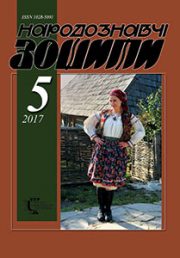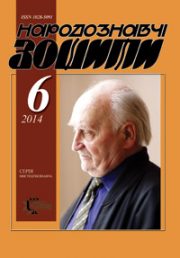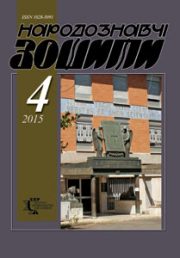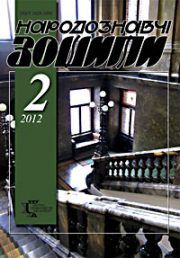The Ethnology Notebooks. 2020. # 6 (156), 1344—1355
УДК 398:7.074(477.86-11)
DOI https://doi.org/10.15407/nz2020.06.1344
Hanna SOKIL
- ORCID ID: https://orcid.org/0000-0002-8352-2124
- doctor of philological sciences, professor,
- Ivan Franko National University of Lviv,
- Str. Universytetska, 1, 79000, Lviv, Ukraine.
- e-mail: gan.sokil@gmail.com
RESEARCH OF BOYKIVSHCHYNA FOLKLORE
Boykivshchyna occupies an important place among other ethnographic regions of Ukraine and has an outstanding folklore fund, which is still not fully represented in scientific researches. The relevance of the article is stipulated by the insufficient studies of folk art of the boykos (people living in Highland areas of the Carpathian Mountains) and research of scientific heritage of those researchers who studied the oral folklore of this region. Boykivshchyna folklore is a part of the whole complex of traditional and everyday culture and is interrelated with its other components (customary and legal, moral and ethical, ceremonial ones), which reveals the historical and ethnographic unity of the ethnos.
The aim of the article is to present a folklore review of Boykivshchyna in records and articles of scholars, to analyze the folk poetry fund through a genre and thematic prism (ritual songs of winter, spring and summer cycle; wedding, family and household songs, kolomyiki; paremias, prose works), to reveal local peculiarities of Boykos’ folklore, its poetic features, to focus on the concepts and principles of studying the ethnocultural tradition of the region in the folklore activities of scholars.
The object of study is ethnocultural tradition of boykos in the folklore activities of I. Vahylevych, I. Franko, O. Rozdolskyi, F. Kolessa, Z. Kuzelia, V. Levynskyi.
The chronological boundaries cover the end of the XIX — first half of the XX century including the middle of the XIX century, which is partially related to the activities of I. Vahylevych. The research is based on the scientific work of the members of the Ethnographic Commission of the Taras Shevchenko Scholarly Society in Lviv, related to the study of Boykivshchyna folklore. The article includes materials of ethnographic expeditions, published in various publications, as well as manuscripts, some of which are introduced into scientific circulation for the first time.
Following the territorial principle, the article focuses on the part of Boykivshchyna that according to the modern administrative division belongs to Drohobych and Skole districts of Lviv region. The study used culturological, comparative, systemic and statistical methods.
Keywords: expedition, ritual-based folklore, folk songs, themes, motive, publication, «Ethnographic Collection».
REFERENCES
- Franko, I. (1982). Old song. In Franko, I. Collection of works: in 50 vol. (Vol. 37, pp. 76—78). Kyiv: Naukova Dumka [in Ukrainian].
- Franko, I. (1982). The Literary language and dialects. In Franko I. Collection of works: in 50 vol. (Vol. 37, pp. 205—210). Kyiv: Naukova dumka [in Ukrainian].
- Wahylewich, I., & Kyrchiv, R. (1978). Boyki, Russian-Slavic people in Galicia, 12, 117—130 [in Ukrainian].
- Vahylevych, I., Shalatа, M.J. (Ed.). (1983). Folk songs in the records of Ivan Vahylevych. Kyjiv: Muzychna Ukrajina [in Ukrainian].
- Franko, I. (1884). The journey of Russian youth. Dilo, 85, 86 [in Ukrainian].
- Franko, I. (2006). Front word to the first volume. Galician-Russian folk tales: in 3 vol. (Vol. 1, pp. 285—304). The second edition. Lviv [in Ukrainian].
- Franko, I. (1986). Letters (1895—1916). In Franko, I. Collection of works: in 50 vol. (Vol. 50). Kyiv: Naukova dumka [in Ukrainian].
- Franko, I. (1986). Letters (1874—1885). In Franko, I. Collection of works: in 50 vol. (Vol. 48). Kyiv: Naukova dumka [in Ukrainian].
- Franko, I. (1981). Curriculum vitae. In Franko, I. Collection of works: in 50 vol. (Vol. 29, pp. 77—84). Kyiv: Naukova Dumka [in Ukrainian].
- Ghnatjuk, V. (1914). Carols and Christmas carols. Ethnographic compendium. Lviv (Vol. 36) [in Ukrainian].
- Dej, O.I. (1981). Folk songs in the records of Ivan Franko. Kyiv: Muzychna Ukrajina [in Ukrainian].
- Dej, O.I. (1955). Ivan Franko and folk art. Kyiv [in Ukrainian].
- Sokil, H. (2011). Folklore of Ivan Franko through the prism of epistolary. Ukrajinsjke literaturoznavstvo (Issue 74, pp. 239—248). Ljviv [in Ukrainian].
- Ghnatjuk, V. (1895). Something about Hungarian Russia. Radykal, 2, 3 [in Ukrainian].
- Ghnatjuk, V. (1902). Galician-Russian folk legends. Ethnographic compendium (Vol. 12, 13). Lviv [in Ukrainian].
- Demyan, G. (1968). My foothills are green, 4, 113—117 [in Ukrainian].
- (1937). Scientific archived funds of manuscripts and sound recordings (The NAFRF IMFE) the name of М.Т. Ryljsjkogho NAN of Ukraine. F. 40—1. Od. zb. 97.
- Sokil, H. (1999). The first scientific expedition of the Lviv branch of the Institute of Folklore to Drohobych. The Ethnology notebooks, 3, 399—401 [in Ukrainian].
- Kolessa, F. (1970). Ukrainian folk song in the latest phase of its development. Folklore works (Pp. 34—59). Kyiv: Naukova dumka [in Ukrainian].
- Sokil, Vasyl, & Sokil, Hanna (1998). Folk materials from the motherland. Lviv [in Ukrainian].
- Ghnatjuk, V. (1899). Galician-Russian anecdotes. Ethnographic compendium. Lviv (Vol. 6) [in Ukrainian].
- Ghnatjuk, V. (1916). Ukrainian folk tales (animal epic). Ethnographic compendium (Vol. 37—38). Lviv [in Ukrainian].
- Barag, L.G, & Berezovsky, I.P. (1979). Comparative index of plots: East Slavic fairy tale. comp. Leningrad: Nauka [in Russian].
- (1902). Meeting of the Ethnographic Commission of October 13, 1902. Chronicle of NTSh. Lviv (Part 12, issue 4, p. 19) [in Ukrainian].
- (1906). Meeting of the Ethnographic Commission of August 21, 1906. Chronicle of NTSh. Lviv (Part 28, issue 4, pp. 13—15) [in Ukrainian].
- (1908). Meeting of the Ethnographic Commission of May 14, 1908. Chronicle of NTSh. Lviv (Part 35, issue 3, p. 19) [in Ukrainian].
- Hnatyuk, V. (1904). Needs for Galician-Ruthenish demonology. Ethnographic compendium (Vol. 15). Lviv [in Ukrainian].
- Franko, I. (2006). Galician-Russian folk tales: in 3 vol. (Vol. 1). The second edition. Lviv [in Ukrainian].
- Hnatjuk, V. (1905). Kolomyjky. Ethnographic compendium (Vol. 17). Lviv [in Ukrainian].
- Franko, I. (1980). Needs to study the language and ethnography of the Ukrainian people. ІІ. Something about Boryslav. Collection of works: in 50 vol. (Vol. 26, pp. 180—204). Kyiv: Naukova dumka [in Ukrainian].
- Levinsky, V. (1908). Boykos wedding in Dobrohostiv, Drohobych district. Materials on Ukrainian-Russian ethnology (Vol. 10) [in Ukrainian].
- Drozd, Dz. (2006). Cathedral Saturday. Belarussian folklore: encyclopedia (Vol. 2, p. 570). Minsk: Belarussian Encyclopedia [in Ukrainian].
- Levinsky, V. (1899—1903). NAFRF IMFE the name of М.Т. Ryljsjkogho NAN of Ukraine. F. 28—3. Od. zb. 79.
- Franko, I. (1982). Ethnographic expedition to Boykos region. Collection of works: in 50 vol. (Vol. 36, pp. 68—99). Kyiv: Naukova dumka [in Ukrainian].
- (2001). Correspondence of Fedor Vovk with Vladimir Hnatiuk. Lviv; Kyiv [in Ukrainian].
- Kuzela, Z. (1908). Boykos wedding in Lavochny, Stryi district. Materials on Ukrainian-Russian ethnology (Vol. 10, pp. 121—150). Lviv [in Ukrainian].
- Ghnatjuk, V. (1910). Folk tales about opryshky. Ethnographic compendium. Lviv (Vol. 26) [in Ukrainian].







